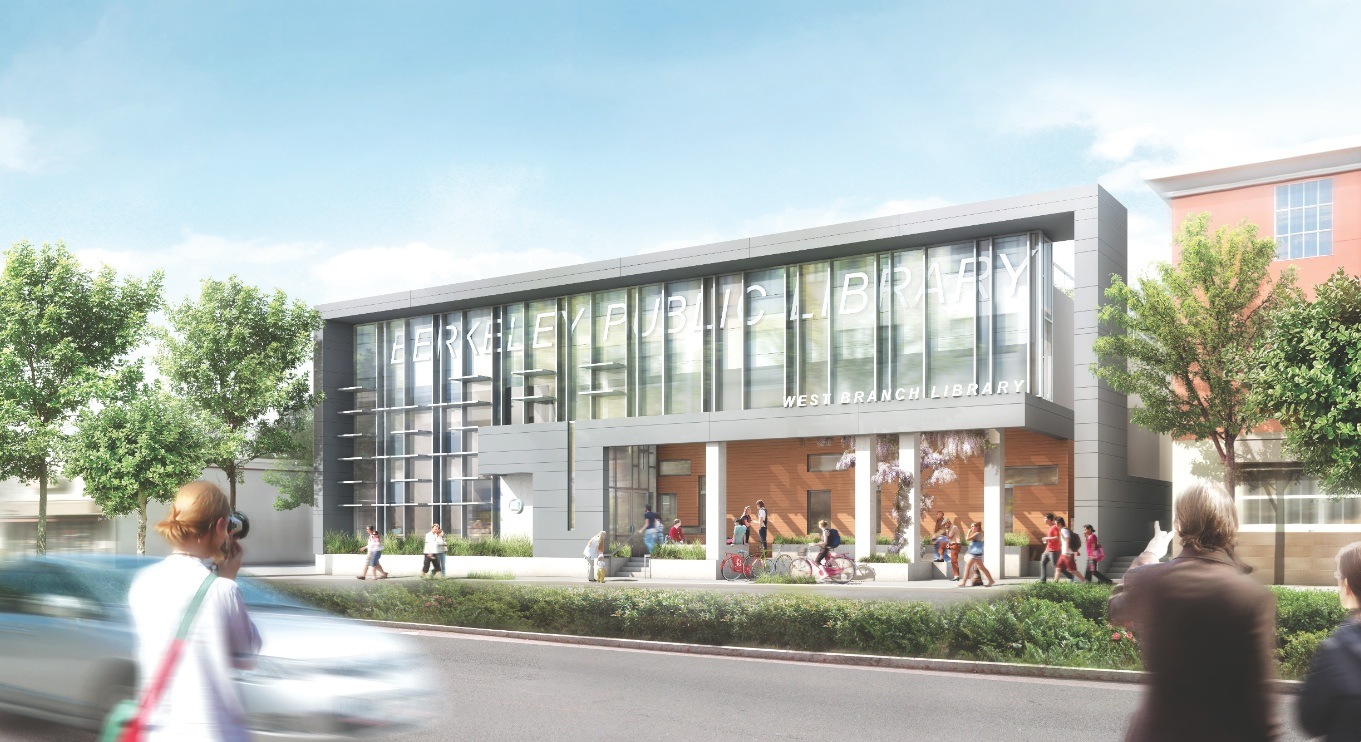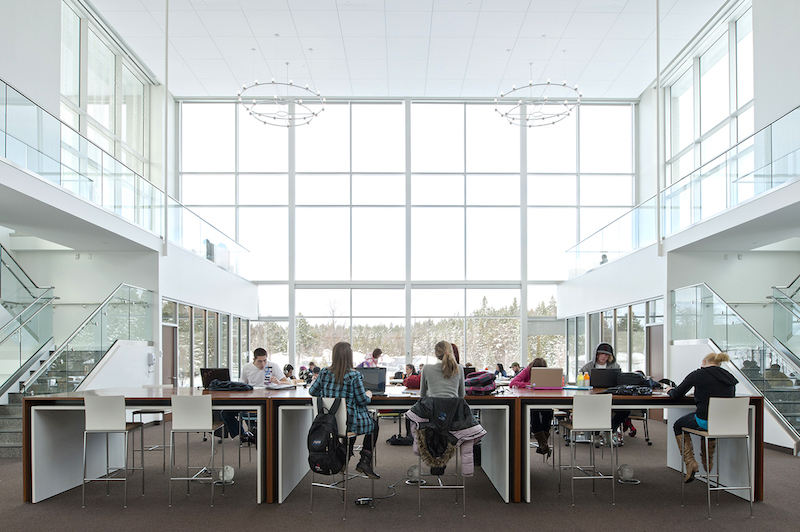Situated on a tiny, quarter-acre lot along bustling University Avenue, Berkeley, Calif.’s, new West Branch library may not be large in stature, but it’s one of the most significant library projects of the year.
Due to open in August, the 9,500-sf facility will join a handful of libraries across the country that are net-zero energy performers. And, if all goes as planned, the facility will achieve net-positive energy performance—supplying power back to the city’s electrical grid—and have a carbon-neutral footprint.
The project’s Building Team, led by Harley Ellis Devereaux’s GreenWorks Studio (www.harleyellisdevereaux.com), is targeting LEED Platinum. The $5.5 million library is one of the first projects to take part in the California Public Utility Commission’s ZNE Energy Pilot Program, supported by the Pacific Gas and Electric Co.
Michael Bulander, LEED AP BD+C, Associate with Harley Ellis Devereaux, says the PG&E partnership was critical to achieving NZE performance on the West Branch project. The utility subsidized early computer modeling work, including computational fluid dynamics analysis of ventilation schemes and a solar axis study for the rooftop solar installations.
The latter was especially tricky, says Bulander, due to the project’s tight urban site. “The starting point for the entire design was actually the building’s roof,” he says. “Because taller buildings surround the tiny site—including a three-story hotel next door—the team had to determine the optimal roof configuration for accommodating as many PV and solar thermal panels as possible, and for minimizing shading from the other buildings.”
Projected Energy Performance
Renewable energy generation
Photovoltaic panels 15.4 kBtu/sf/year
Solar thermal panels 2.0 kBtu/sf/year
Total power generation 17.4 kBtu/sf/year
Building electrical load
Lighting 3.8 kBtu/sf/year
Heating 3.5 kBtu/sf/year
Cooling (heat pumps) 2.2 kBtu/sf/year
Plug load 6.3 kBtu/sf/year
Hot water 0.9 kBtu/sf/year
Ventilation fans 0.7 kBtu/sf/year
Total power load 17.4 kBtu/sf/year
Net energy consumption 0.0 kBtu/sf/year
The rooftop solar panels also had to compete for space with three rows of skylights that were instrumental to the building’s daylighting scheme. And, of course, the roof configuration had to meet the programmatic requirements for the library.
“It was a real balancing act,” says Gerard Lee, AIA, LEED AP, Associate and Project Manager with Harley Ellis Devereaux. “We had to find the sweet spot between what the building wanted to be from a program standpoint and what it should be from an energy-performance standpoint.”
Through modeling, the design team determined that the optimal design consisted of a compact, rectangular roof, 24 feet high. The solar panels are oriented horizontally, stacked three high at a 20-degree angle to maximize solar collection throughout the year. Four PV arrays are interspersed between three rows of skylights. A total of 120 panels will generate 75,050 kWh/year with a final system efficiency of 93.8%. The 16 solar thermal panels are located in two arrays at the northeast corner of the roof.
“The design takes into consideration the skylight locations and heights,” says Lee. “The PV panels are angled and located to avoid casting shadows on the skylights, and the same can be said for the skylights.”
The team modeled the design to maximize the number of solar panels that could be installed on the compact roof. The photovoltaic and solar thermal panels were situated so as not to interfere with the three rows of skylights.
Once the roof design scheme was established and the team could accurately calculate the amount of solar energy that would be harvested, they went about designing the building to minimize the energy use intensity to match the renewable energy supply.
“Our EUI is very low in relation to other projects—just 17 kBtu/sf/year,” says Bulander. For comparison, the average office building has a EUI of 193; hospitals can exceed 500.
Passive design requires careful modeling, detailing
Passive design strategies like natural ventilation, radiant heating/cooling, and daylighting helped meet the aggressive energy goals. Prevailing winds off the Bay made natural ventilation a logical approach, but the site proved problematic yet again. Because the building is located in a high-traffic area next to a stoplight, placing operable windows in the main façade was not feasible. “Trucks often wait at the red light in front of the building,” says Bulander. “We needed to block that out.”
To minimize energy consumption in the building, the design scheme utilizes daylighting through a series of skylights and a large glass curtain wall on the main façade. Where possible, the team minimized the amount of electrical lighting in the building, such as in the back office areas. When the library closes for the day, the entire facility will essentially go dark to reduce energy use.
With the help of CFD modeling, the design team devised a clever natural ventilation scheme that uses negative pressure to pull in fresh air at the rear of the building and then circulate it through the interior spaces.
“We’re essentially using the steady wind that is blowing over the top of the front façade to create a negative pressure that pulls the air through the building,” says Lee. A series of louvers and ventilation fans at the roof level will exhaust the warm air as needed, and radiant flooring will provide supplemental heating and cooling. A building automation system will monitor and control the entire process, ensuring that the interior climate remains comfortable for the staff and patrons.
“We’re trying to make the facility as automated and foolproof as possible,” says Lee. He says the BAS will allow staff to override certain settings—such as closing an operable window on an unusually windy day—but it will automatically revert to its programmed settings at the end of the day. “For the most part, it’s a very intelligent building that needs very little interference from the librarians and staffers.”
As with any net-zero building project, plug loads are a major concern for the Building Team. Library patrons will notice a dearth of outlets in the new facility. This is meant to minimize the number of people who plug in their energy-gobbling laptops, smart phones, and tablets. The library will offer free computer and Internet access for visitors, but in lieu of desktops that are plugged in all day, users will be able to check out fully charged laptops. A charging station will allow the staff to track and control the amount of energy being consumed by the computers.
Lee and Bulander are fully confident that the library staff and patrons will embrace the resource conservation efforts. A building performance dashboard will greet all visitors at the main entrance, providing a real-time snapshot of the building’s energy production and energy/water consumption.
“We’re taking advantage of the ‘Prius effect,’” says Bulander. “When you see a display showing how much energy and water you’re using, you feel more involved in trying to minimize it. It becomes a game.”
The building’s natural ventilation scheme involves pulling in outdoor air from the rear of the building and circulating it throughout the interior spaces. A series of louvers and fans at the roof level will exhaust the air as needed.
PROJECT SUMMARY
Berkeley Public Library – West Branch
Berkeley, Calif.
BUILDING TEAM
Client: City of Berkeley, Calif.
Architect, sustainability consultant, commissioning agent: Harley Ellis Devereaux, GreenWorks Studio
General contractor: West Bay Builders
MEP engineer: Harley Ellis Devereaux
Structural engineer: Tipping Mar
Civil engineer: Moran Engineering
Landscape architect: John Northmore Roberts and Associates
Cost estimator: Cumming Corp.
GENERAL INFORMATION
Size: 9,500 sf
Cost: $5.5 million (est.)
Completion: August 2013
Related Stories
| Aug 11, 2010
Polshek Partnership unveils design for University of North Texas business building
New York-based architect Polshek Partnership today unveiled its design scheme for the $70 million Business Leadership Building at the University of North Texas in Denton. Designed to provide UNT’s 5,400-plus business majors the highest level of academic instruction and professional training, the 180,000-sf facility will include an open atrium, an internet café, and numerous study and tutoring rooms—all designed to help develop a spirit of collaboration and team-oriented focus.
| Aug 11, 2010
University of Florida aiming for nation’s first LEED Platinum parking garage
If all goes as planned, the University of Florida’s new $20 million Southwest Parking Garage Complex in Gainesville will soon become the first parking facility in the country to earn LEED Platinum status. Designed by the Boca Raton office of PGAL to meet criteria for the highest LEED certification category, the garage complex includes a six-level, 313,000-sf parking garage (927 spaces) and an attached, 10,000-sf, two-story transportation and parking services office building.
| Aug 11, 2010
Draft NIST report on Cowboys practice facility collapse released for public comment
A fabric-covered, steel frame practice facility owned by the National Football League’s Dallas Cowboys collapsed under wind loads significantly less than those required under applicable design standards, according to a report released today for public comment by the Commerce Department's National Institute of Standards and Technology (NIST).
| Aug 11, 2010
Callison, MulvannyG2 among nation's largest retail design firms, according to BD+C's Giants 300 report
A ranking of the Top 75 Retail Design Firms based on Building Design+Construction's 2009 Giants 300 survey. For more Giants 300 rankings, visit http://www.BDCnetwork.com/Giants
| Aug 11, 2010
USGBC honors Brad Pitt's Make It Right New Orleans as the ‘largest and greenest single-family community in the world’
U.S. Green Building Council President, CEO and Founding Chair Rick Fedrizzi today declared that the neighborhood being built by Make It Right New Orleans, the post-Katrina housing initiative launched by actor Brad Pitt, is the “largest and greenest community of single-family homes in the world” at the annual Clinton Global Initiative meeting in New York.
| Aug 11, 2010
AIA report estimates up to 270,000 construction industry jobs could be created if the American Clean Energy Security Act is passed
With the encouragement of Senate majority leader Harry Reid (D-NV), the American Institute of Architects (AIA) conducted a study to determine how many jobs in the design and construction industry could be created if the American Clean Energy Security Act (H.R. 2454; also known as the Waxman-Markey Bill) is enacted.
| Aug 11, 2010
Architect Michael Graves to be inducted into the N.J. Hall of Fame
Architect Michael Graves of Princeton, N.J., being inducted into the N.J. Hall of Fame.
| Aug 11, 2010
Modest rebound in Architecture Billings Index
Following a drop of nearly three points, the Architecture Billings Index (ABI) nudged up almost two points in February. As a leading economic indicator of construction activity, the ABI reflects the approximate nine to twelve month lag time between architecture billings and construction spending.










